Build Smarter: The Ultimate C-Suite App Development Checklist
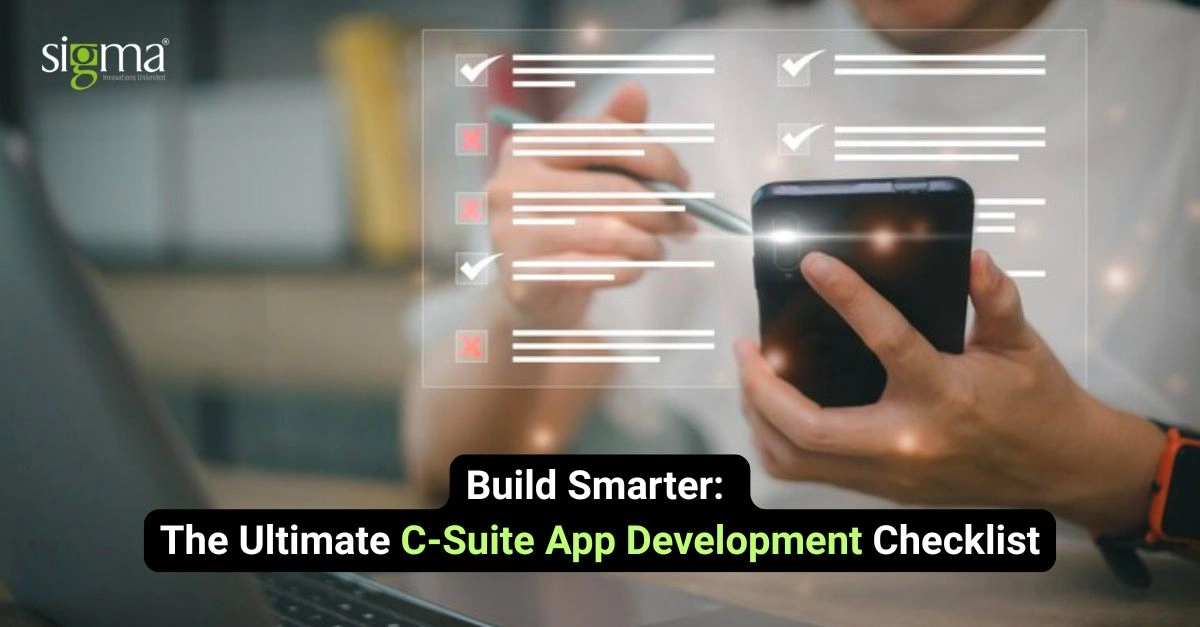
Smarter apps are crucial in our always-connected world; this isn’t just for the tech team, it’s a boardroom imperative. For C-level leaders, mobile app development services and web app development services are now more than digital tools—they’re strategic growth engines. From delivering frictionless customer experiences to unlocking new revenue streams, apps are shaping how businesses compete and win in the market.
The truth is, building an app isn’t just about hiring a few developers and coding your way through it. It’s about aligning technology with business goals. Whether you’re launching a sleek eCommerce platform or rethinking your internal Salesforce workflows, the right app development services can move the needle on growth, innovation, and digital efficiency—all in one shot.
And it’s not just about choosing between iOS app development services or web-first builds. C-suite executives today must also consider things like scalability, security, cross-platform capabilities, and time-to-market. That’s where this checklist comes in.
This ultimate guide is built specifically for decision-makers—CEOs, CTOs, CIOs, and CMOs—who need clarity without the tech jargon, control over project timelines and ROI, and a real competitive edge. Whether you’re exploring hybrid app development services or scaling with mobile app development services in USA, this checklist will help you build smarter—not just faster.
Let’s help you make better app decisions that support your business goals and give you a product you’ll be proud to stand behind.
Strategic Vision & Business Alignment
Before writing the first line of code or choosing between iOS app development services and web app development services, one big question must be answered: Why are we building this app in the first place?
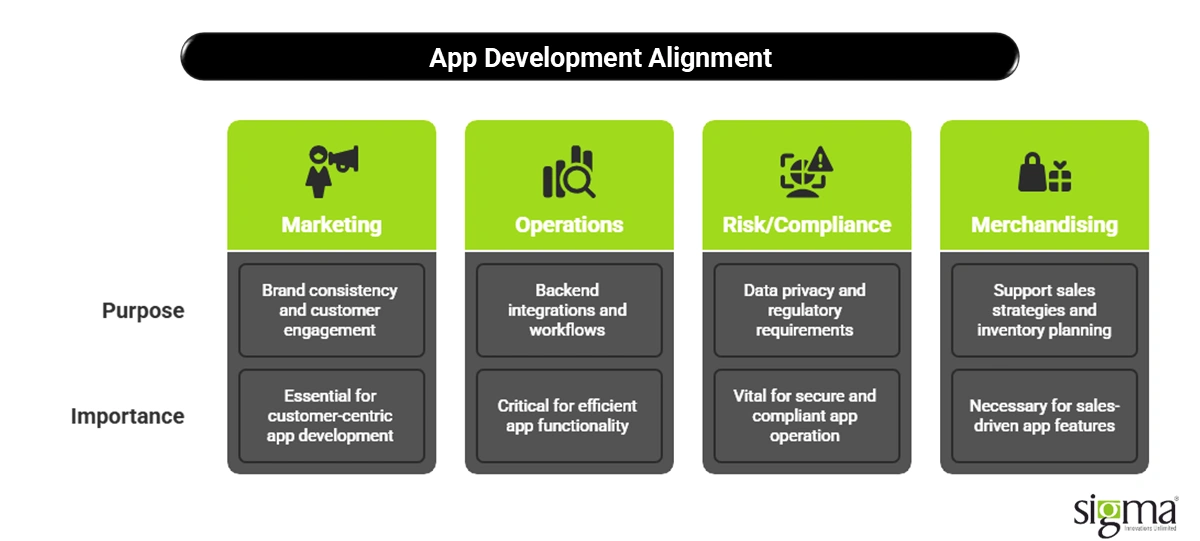
Today’s app development services aren’t just about solving tech challenges—they’re about driving business growth. Whether it’s creating new revenue streams, improving customer experience, or streamlining internal operations, every mobile app should have a clear business case. And that case should be tightly aligned with your company’s overall strategy.
Start with the Business Model
If your app doesn’t directly support how your business makes money or adds value to your customers, it’s probably not worth building. For example, in the FinTech space, your app might streamline onboarding or increase loan application conversions. In eCommerce, it might mean boosting average cart value or reducing bounce rates.
That’s why aligning your app strategy with revenue models and customer journeys is key. Leading mobile app development services in the USA emphasize the “why” before jumping into the “how.”
Align with KPIs & Digital Goals
No app should live in a vacuum. Instead, it should align with your larger digital transformation roadmap. Set performance KPIs early on—downloads, user retention, customer satisfaction, ROI, or operational cost reduction. These become your north stars. And whether you’re exploring hybrid app development services or cross-platform mobile app development services, measurable outcomes matter more than feature lists.
Cross-Functional Buy-In Is Non-Negotiable
Apps are no longer the sole responsibility of IT. A smart build pulls in voices from every critical team:
- Marketing for brand consistency and customer engagement.
- Operations for backend integrations and workflows.
- Risk or Compliance in FinTech to manage data privacy and regulatory requirements.
- Merchandising in eCommerce to support sales strategies and inventory planning.
Too often, we’ve seen apps fail—not because the code was buggy—but because decision-makers weren’t aligned from day one.
By involving key stakeholders early and documenting their input, you reduce back-and-forth, save budget, and launch faster.
Think of your app like building a new retail store. You wouldn’t start construction without agreeing on the location, layout, or merchandise strategy. Same goes here.
C-Suite Checklist
- Is the app vision aligned with business goals?
- Have success KPIs (downloads, retention, ROI) been defined?
- Is stakeholder alignment documented?
Market Research, User Personas & Competitive Analysis
Building your app without market research is like launching a ship with no map. You might move, but you’ll likely drift off course.
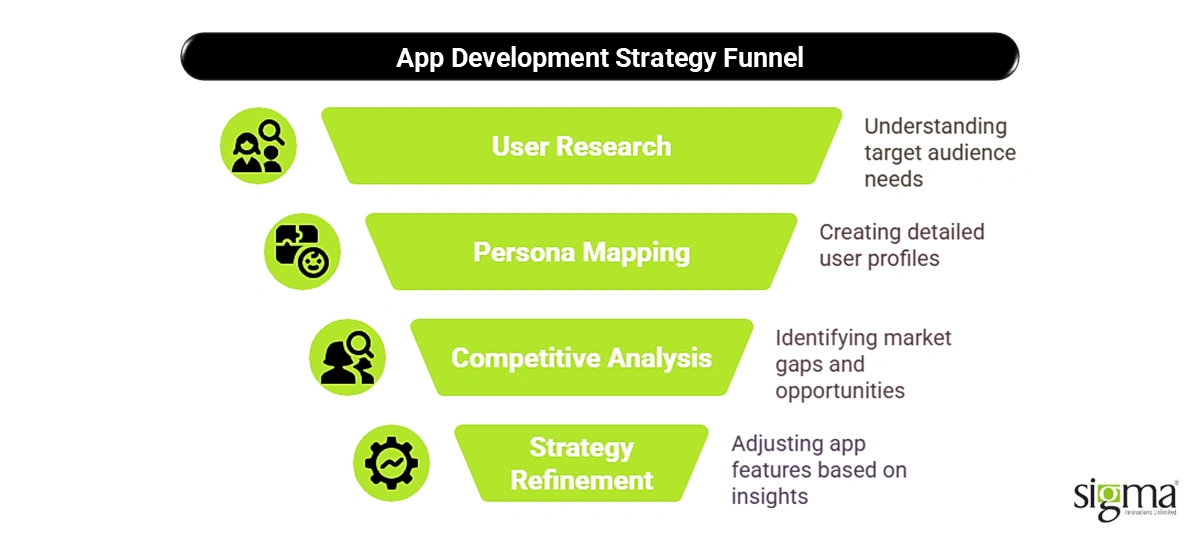
Similarly, you wouldn’t launch a product without knowing your customer. The same goes for mobile apps. Whether you’re investing in iOS app development services or planning a scalable web app, smart decisions start with solid research.
Know Your Users—Before You Build
Who is this app for? That’s the first question your team needs to answer. Identifying both primary and secondary users—and understanding what they expect—is the foundation for any successful app. Are they tech-savvy Gen Z shoppers on an eCommerce platform? Or small business owners applying for a loan on the go?
Once you have that clarity, mapping user personas and journeys gives your app development services team direction. It helps designers and developers focus on features that matter most to your target audience—and ignore the rest.
Scope Out the Competition
Chances are, your competitors already have apps out there. That’s not a bad thing. In fact, it’s your secret weapon. By analyzing what others in your space are doing—using tools like App Annie, Sensor Tower, or SimilarWeb—you can uncover gaps, opportunities, and ways to stand out.
Look at their app’s functionality, UX, monetization model, and user retention metrics. If they’re doing something great, learn from it. If users complain about certain features or bugs, avoid the same mistakes in your mobile app development services strategy.
C-Suite Checklist
- Have user personas and journeys been mapped?
- Has a competitive gap analysis been done?
- Is market demand validated with data?
Platform & Tech Stack Decisions
Here’s where strategy meets execution. Choosing the right platform and tech stack can make or break your app—not just at launch, but throughout its entire lifecycle. And let’s be honest, no one wants to invest in a digital asset that becomes outdated in a year.
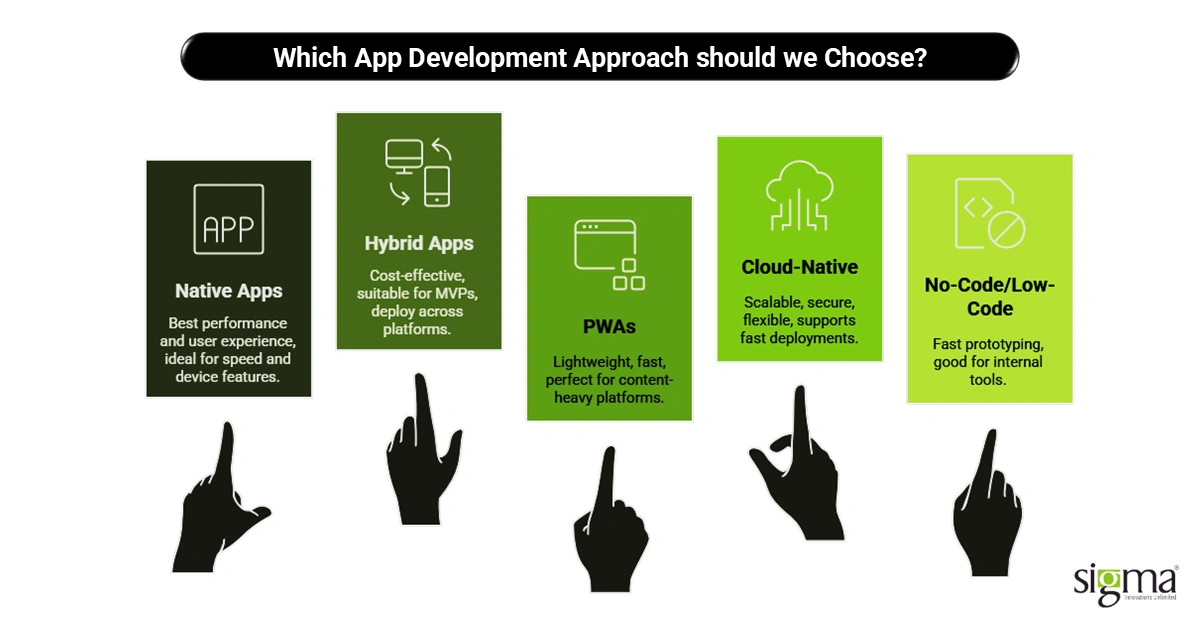
Think of your tech stack like building materials. You wouldn’t build a skyscraper with plywood. The right foundation ensures your app stands strong for years.
Native vs. Hybrid vs. PWA
Let’s start with the big one: native, hybrid, or Progressive Web Apps (PWA)?
- Native apps (built separately for iOS and Android) deliver the best performance and user experience. Ideal when speed, device features, and fluidity matter.
- Hybrid app development services, on the other hand, let you build once and deploy across platforms. They’re cost-effective and great for MVPs.
- PWAs are web apps with native-like functionality—lightweight, fast, and perfect for reach-driven use cases like content-heavy eCommerce platforms.
The latest trends indicate a rise in cross-platform mobile app development services, particularly among businesses that prioritize speed to market and unified experiences. Choosing this route makes sense if your users are spread across iOS and Android devices.
Cloud-Native, Headless & API-First
If you’re aiming for scale, security, and flexibility, consider a cloud-native architecture with a headless CMS and an API-first approach. This combo supports fast deployments, third-party integrations, and omnichannel scalability. It also pairs well with Salesforce app development services and other enterprise backends.
No-Code/Low-Code Tools: A Growing Trend
Platforms like those discussed in Kovaion’s article show how low-code/no-code development is helping businesses prototype and launch faster. While they may not be perfect for every use case, they offer a strong starting point—especially for internal tools or test apps.
C-Suite Checklist
- Is the platform choice aligned with user demographics and speed to market?
- Is the tech stack scalable, secure, and maintainable?
- Are DevOps and CI/CD pipelines pre-planned?
UX/UI Design Planning
Here’s a hard truth: even the smartest app will fail if the user experience is clunky. No one wants to fumble through a confusing interface. That’s why UX/UI design isn’t just a creative task—it’s a strategic one.
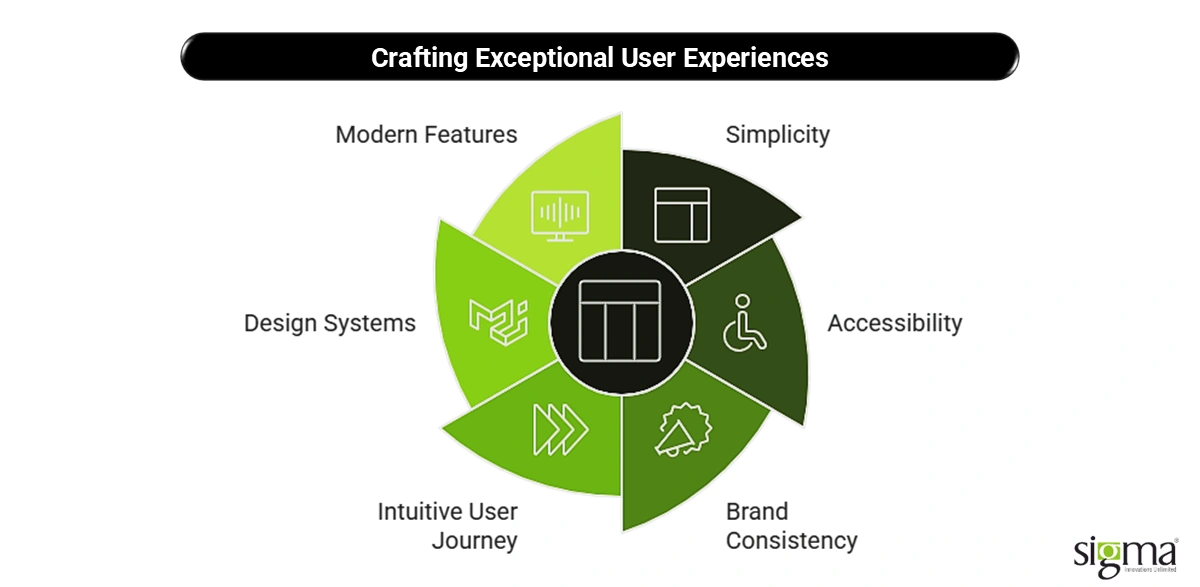
Think of your app like a retail store. The layout should be clean, the signs readable, and the checkout effortless. Whether you’re building through mobile app development services or scaling through web app development services, the design must strike a balance between simplicity, accessibility, and brand consistency. This is where good apps become great.
Design with Purpose
Start by mapping an intuitive user journey. Ask yourself: Can users complete core tasks in 2–3 taps? Are actions predictable and navigation seamless? Design systems like Google’s Material Design or Apple’s Human Interface Guidelines give your team a strong foundation. Add in motion design for feedback and flow, and you’re well on your way.
Modern apps also need to go beyond the basics. Dark mode, voice UI, and gesture-based navigation aren’t just trends—they’re part of the evolving mobile experience. Especially for businesses relying on iOS app development services, these elements are expected by today’s users.
Accessibility Is Non-Negotiable
Make sure your app supports screen readers, readable fonts, and tap-friendly elements. Whether it’s an internal tool built via Salesforce app development services or an external eCommerce app development service, inclusivity boosts adoption—and it’s just good business.
C-Suite Checklist
- Is the user journey intuitive and streamlined?
- Is the UI consistent across platforms and devices?
- Are accessibility and inclusivity standards met?
Security, Compliance & Privacy Readiness
Think of security like seatbelts in a car. You hope you won’t need them—but they should be the first thing installed. If you’re in FinTech or eCommerce, security isn’t optional—it’s the foundation. Whether you’re working with mobile app development services or rolling out enterprise web app development services, protecting sensitive data must be baked into the build from day one.
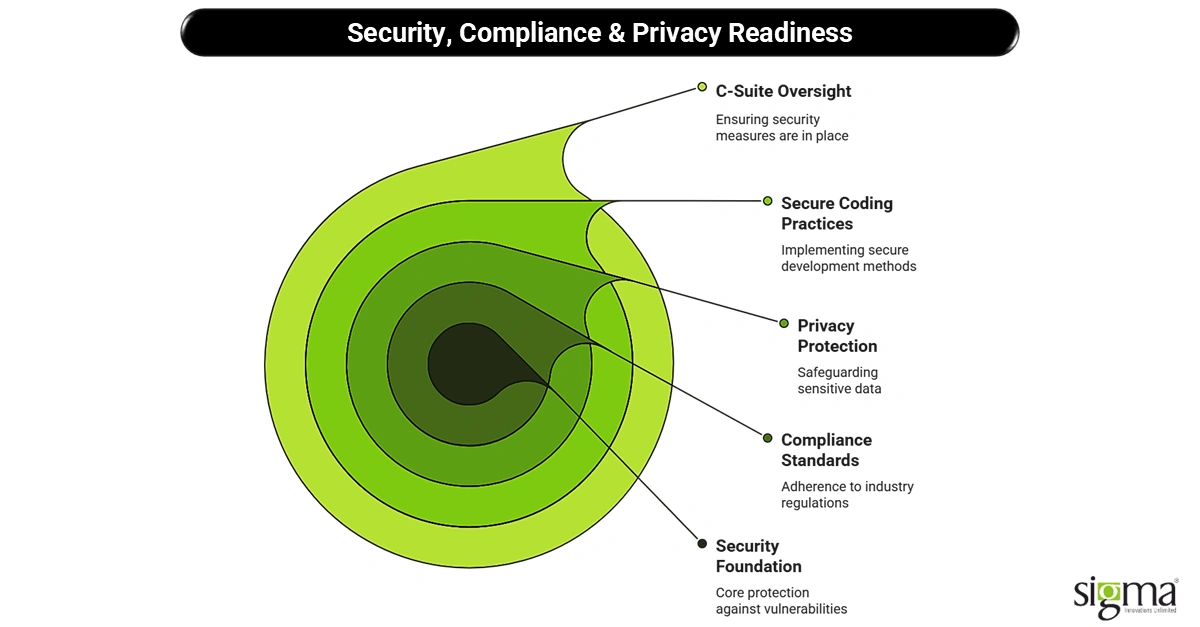
Today, apps handle personally identifiable information (PII), financial data, health records, and other sensitive data. That means you’re operating in a world shaped by PCI-DSS, GDPR, SOC 2, and HIPAA—depending on the region and domain. The risk? A single vulnerability could cost you millions, not just in fines, but in trust.
Top-tier app development services now prioritize end-to-end encryption, secure authentication (think MFA and biometrics), and threat modeling. Referencing security checklists from platforms like Adjust and Sumo Logic is a great way to benchmark your app against industry standards.
Read the blog to know more about the Security Compliance Checklist for a Fintech CTO
Secure by Design
Good security isn’t something you slap on later—it’s built into the foundation. Developers must follow OWASP Mobile Top 10 secure coding practices, adopt secure CI/CD pipelines, and conduct regular code reviews. Whether you’re scaling with iOS app development services or Salesforce app development services, compliance audits must be part of your go-live roadmap.
C-Suite Checklist
- Is data encryption implemented end-to-end?
- Are compliance audits planned?
- Are secure coding best practices followed?
Read the blog to know about the top 8 Security Testing Tools for Web Applications.
App Development Process (Agile & QA First)
Once the strategy, tech stack, and design are in place, it’s go-time. But building smarter doesn’t mean building everything at once. The smartest app development services teams today embrace Agile methodologies—because they keep projects flexible, testable, and aligned with business needs at every sprint.

Think of Agile as building with Lego blocks. You build one section, test it, improve it, then build the next—without waiting for the whole set to be done.
Agile, Scrum, Kanban, or a Blend?
There’s no one-size-fits-all model. Agile offers the flexibility to adapt quickly to market feedback. Scrum works great when your app has frequent feature updates and tight deadlines. Kanban is ideal for teams focused on continuous delivery and flow.
Many leading mobile app development services in the USA follow a hybrid Agile approach—blending Scrum‘s structure with Kanban’s visibility. The goal? Stay lean, stay fast, and minimize bottlenecks.
MVP First, Always
Before diving into a full-fledged product, define a Minimum Viable Product (MVP)—a lean version of your app that delivers the core value to users. Whether it’s an eCommerce app development service or a Salesforce app development service, launching fast and learning faster is the name of the game. Build. Launch. Learn. Iterate.
QA Isn’t a Phase—It’s a Habit
Don’t wait until the end to test. The best web app development services and iOS app development services integrate automated testing, manual QA, regression testing, and user acceptance testing (UAT) into every sprint. Continuous testing reduces bugs, ensures security, and saves costs long term.
CI/CD pipelines also help ensure that code is always in a deployable state—critical when speed to market matters.
C-Suite Checklist
- Is the MVP scope defined?
- Are sprints and testing cycles planned?
- Is the QA process automated and integrated?
Performance, Analytics & Usability Testing
Once your app goes live, the work doesn’t stop—it evolves. And that’s where performance and analytics play a major role. A flashy app with poor performance is like a sports car that stalls at every stoplight. Not a great look, especially in the competitive B2B markets across industries and verticals.
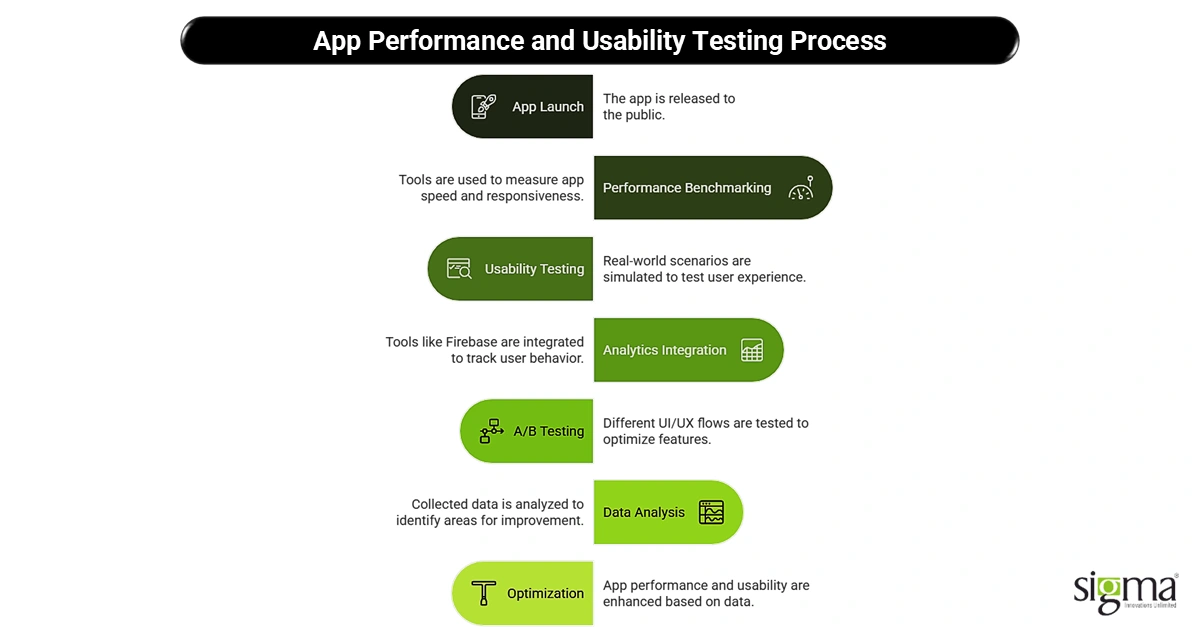
Fast, Responsive, and Always-On
Whether it’s a mobile app development service or a full-scale web app development service, users today expect lightning-fast loading, minimal lag, and smooth navigation—even in low-connectivity zones. Think offline mode, low latency, and the ability to scale under load.
Use performance benchmarking tools from day one and simulate real-world usage scenarios. Can your app handle peak traffic? Is it optimized for both iOS and Android users? If you’re building through iOS app development services or cross-platform mobile app development services, make sure your speed matches user expectations on every device. A slow app is like a long checkout line. People will leave—even if your products are great.
Usability Isn’t a Guess—It’s Tested
Detailed usability testing should happen before, during, and after the launch. Platforms like Capaciteam’s checklist are helpful guides. Your QA team should simulate real-world usage, test gesture responsiveness, button placements, and screen flows for real humans—not just for ideal users.
Measure What Matters
Integrate analytics tools like Firebase, Mixpanel, or Segment into the core build—not later. These tools help track user behavior, retention rates, drop-off points, and feature engagement.
Planning A/B testing for various UI/UX flows also helps optimize features based on real data—not hunches.
This data is your early warning system and your competitive edge. It tells you what’s working, what’s not, and where to pivot next.
C-Suite Checklist
- Is performance benchmarking in place?
- Have you planned A/B testing for UX flows?
- Are usage analytics integrated?
Go-to-Market Strategy & Post-Launch Plan
You’ve built the app. Now it’s time to bring it to market—and make sure it actually thrives. A smart go-to-market (GTM) plan can be the difference between an app that gets ignored and one that gains traction fast. Whether you’ve worked with mobile app development services or web app development services, the launch phase is where strategy meets execution.
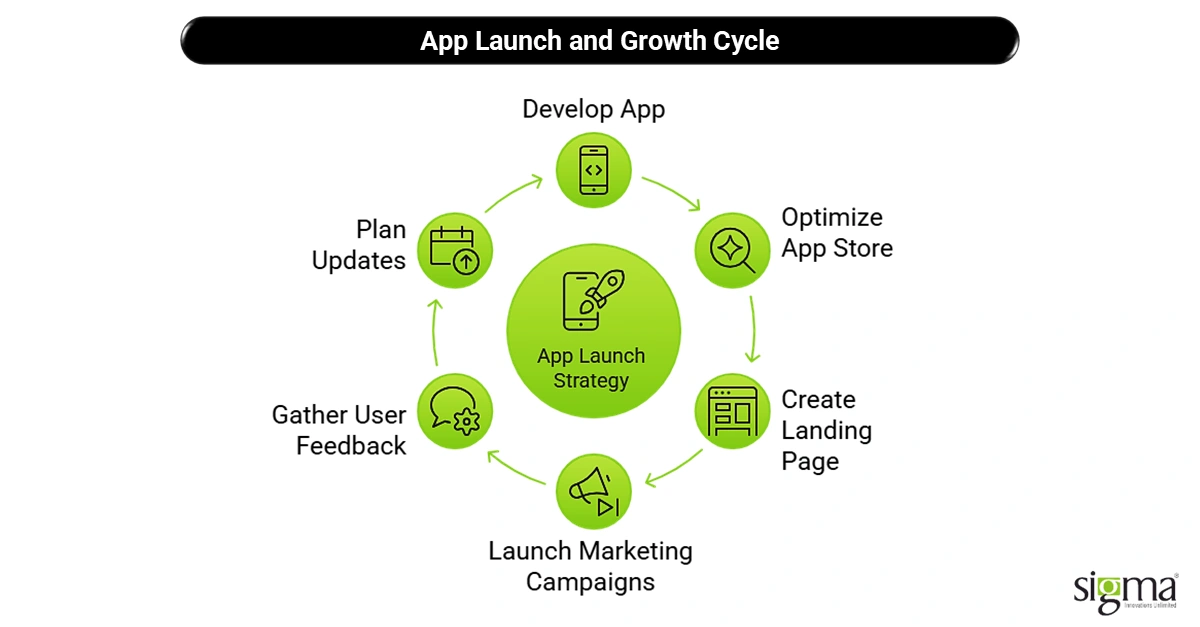
Launch Like a Pro
Start with App Store Optimization (ASO). It’s SEO for the app world—your name, keywords, screenshots, and reviews all matter. Next, create a high-converting landing page that tells your app’s story to potential users. Add paid user acquisition (UA) campaigns and, if it fits your space, tap into influencer partnerships or targeted content marketing.
Especially for eCommerce app development services, creating early buzz with promos or referral programs can drive app installs and first transactions. Launching an app without a GTM plan is like opening a store with no signboard—you exist, but no one knows.
Real-Time Feedback & Support Readiness
Once your app is out there, make it easy for users to talk to you. In-app feedback forms, chatbots, and easy-to-access support channels are essential. Whether it’s an iOS app development service or a Salesforce app development service, feedback loops help you fix bugs fast and build what users actually want.
Plan Beyond Day 1
Think of launch as just Day 1. Plan your versioning and feature release cycles early. Will you update monthly? Quarterly? Align these updates with customer training, marketing communications, and support documentation. With cross-platform mobile app development services, make sure updates go live on iOS and Android simultaneously.
C-Suite Checklist
- Is the ASO and GTM plan ready?
- Is there a feedback mechanism live within the app?
- Are release cycles and communication documented?
Budgeting, ROI Tracking & Vendor Selection
Let’s talk money—because building smarter doesn’t mean spending blindly. Whether you’re working with mobile app development services in the USA or considering global teams, understanding the total cost of ownership (TCO) is key.
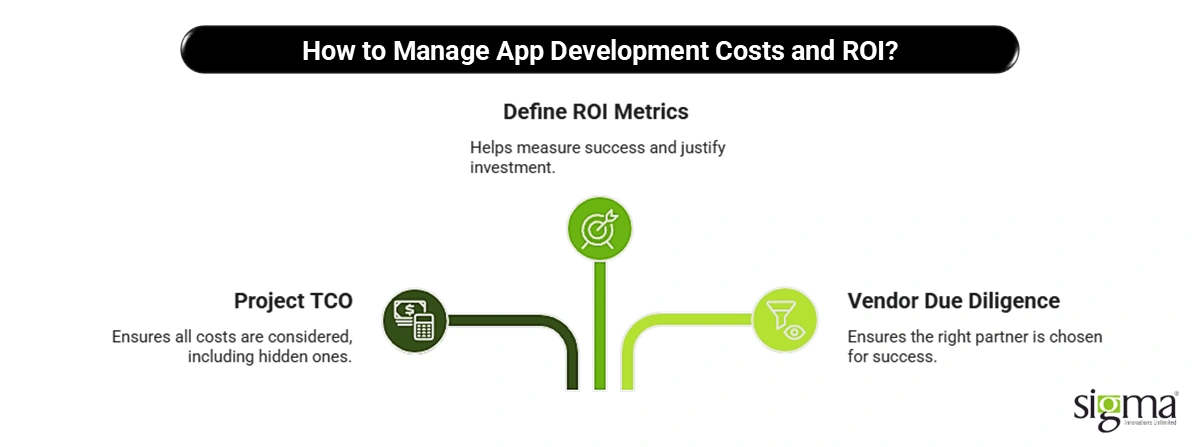
Cost Is More Than the Code
While most C-suites expect to budget for app development services, many forget about hidden costs. These include API integrations, third-party services, cloud hosting, ongoing support, and analytics tools like Mixpanel or Firebase. Then there’s maintenance—updates, patches, and future enhancements. Resources like SPDLoad and AppInventiv offer good ballpark ranges, but your app’s features, complexity, and tech stack will shape your actual cost.
Measuring ROI from the Start
Define how success will be measured before the first line of code is written. Are you looking at app downloads, user retention, customer acquisition cost (CAC), or pure revenue uplift? This helps you decide which tools and features justify the investment—especially in cases involving eCommerce app development services or Salesforce app development services, where outcomes tie directly to conversions or productivity.
Think of ROI like a fitness tracker. Without one, you’re just sweating. With one, you know what’s working.
Outsource or In-House?
For most businesses, outsourcing to expert web app development services or iOS app development services is faster and more cost-efficient than building a team from scratch. Just ensure your vendor has strong references, domain experience, and clear SLAs. The right partner makes or breaks your app journey.
Power Your Business with Sigma’s End-to-End Mobile App Development Services — From intuitive design to seamless integration and enterprise-grade management, we’ve got your app needs covered!”
C-Suite Checklist
- Is the TCO (Total Cost of Ownership) projected?
- Have ROI tracking metrics been defined?
- Is the vendor’s due diligence complete?
C-Suite Red Flags: Mistakes to Avoid
Even the smartest business leaders can fall into avoidable traps when navigating app development services. In today’s fast-paced digital world, the pressure to launch can often outweigh the need to launch right. Here are the most common red flags every executive team should keep on their radar.
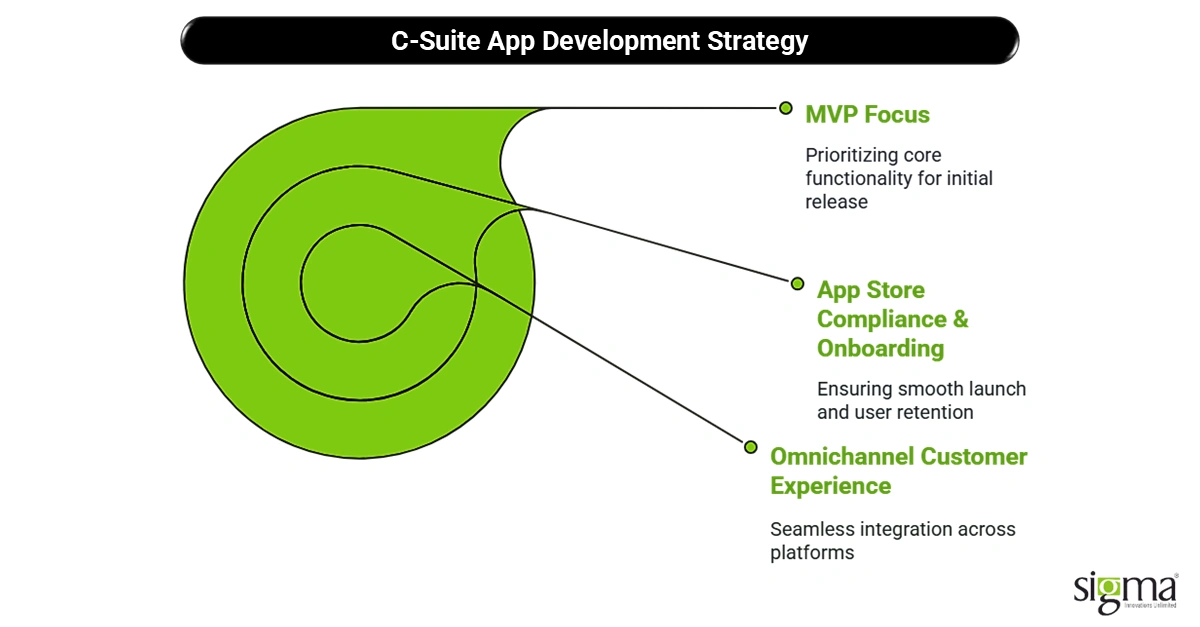
1. Trying to Build Everything at Once
It’s tempting to pack every feature into version 1. But doing that often leads to bloat, bugs, and burnout. Whether you’re leveraging web app development services, mobile app development services, or even eCommerce app development services, think MVP first. Focus on core functionality, get feedback, and evolve with real usage insights.
2. Ignoring App Store Compliance & Onboarding
App store rejections (especially on iOS) can derail your timeline. And poor onboarding experiences can kill retention in the first week. If your iOS app development services or cross-platform mobile app development services partner isn’t laser-focused on store compliance, accessibility, and onboarding UX, that’s a red flag.
3. Treating Mobile as a Silo
Your app isn’t just an app—it’s a part of your omnichannel customer experience. Treating it as a standalone asset instead of integrating it with CRM, POS, and customer service tools (like Salesforce app development services) is a missed opportunity. Customers expect continuity—across devices, channels, and platforms.
C-Suite Checklist
- Have we prioritized MVP over feature overload?
- Is the onboarding and compliance workflow tested?
- Is our app connected to the broader CX strategy?
Final Thoughts
Building a smarter app is like constructing a modern skyscraper—you need a solid blueprint, strong materials, and the right crew. The most successful digital leaders understand that great apps don’t happen by chance. They’re a product of strategy, execution, and scalability. Whether you’re exploring mobile app development services, web app development services, or building for both Android and iOS, the same truth applies: smart planning wins.
Over the past eleven sections, we’ve walked you through everything your C-suite needs to stay in control—from aligning business goals and identifying your ideal tech stack, to security, usability, and performance. We’ve also uncovered red flags that can derail even the most promising app projects.
At Sigma Infosolutions, we’ve helped businesses across FinTech, eCommerce, and beyond build high-performing digital products with speed and precision. Whether you’re considering iOS app development services, eCommerce app development services, or even cross-platform mobile app development services, our team brings decades of experience, cross-domain insights, and agile execution.
The global application development software market, estimated at US$195.77 billion, is projected to reach US$195.77 billion by 2030, growing at a CAGR of 5.09%! The number states one fact: C-suite is in the race to get an app for their business! Ready to get started? If you’re a CTO, CIO, or Chief Digital Officer looking to transform your app vision into a scalable product, let’s connect. We offer full-spectrum application development services—from strategy and design to launch and post-launch success.